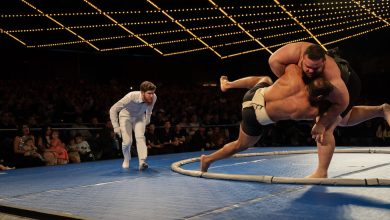Jakob Ingebrigtsen Wins the 5,000. ‘I Wanted to Prove that I’m a Better Runner.’

In recent years, Jakob Ingebrigtsen has collected a small constellation of tattoos on his arms and legs. A crescent moon near his right biceps. A compass on his left forearm. A palm tree and the face of a dog above his right knee. A serpent on his left thigh. The tattoos are a source of fascination for track and field fans.
Ingebrigtsen, though, has seldom, if ever, spoken publicly about them.
“Everybody asks about them, but I usually doesn’t say anything about the meaning,” he said last month in an interview while he was training with his older brother Henrik in Flagstaff, Ariz. “What’s so funny about athletics is that the normal fan is like a Ferrari fan. They’re purists. They want the sport to be like how it used to be: white singlets, split shorts and mustache.”
They want everyone to look like Steve Prefontaine?
“Basically,” Jakob Ingebrigtsen said. “They don’t want to see any changes: no new shoes, no lights, no new tracks.”
He went on: “Have you heard about the Ferrari owners? If they modify their cars, the company removes them from their lists. Because they don’t want anything to do with modifying their cars. They’re not allowed to buy another car from them. That’s how it is with athletics.”
So, the tattoos are a way of being rebellious?
“In some ways,” he said. “It’s also a way of expressing ourselves and saying, ‘We’re not looking at the runners in the ’80s and ’90s as our heroes. We don’t want to be like them. They’re fast, and they have most of the records. But we want to beat the records.’ ”
Ingebrigtsen, 21, has always done things his way, and it was more of the same at the world championships in Eugene, Ore. He told people what he thought — diplomacy be damned — and did what he wanted.
On Sunday, in the 5,000-meter final, he clearly wanted to win. Clad in his Norwegian speed suit, with half of the track bathed in early-evening sunlight behind him, Ingebrigtsen pulled away for his first world championship, winning in 13 minutes 9.24 seconds.
“My race plan?” he said before pausing to ponder the question. “I just wanted to win. And I wanted to win by as much as possible. I didn’t want a sprint finish, because then some people would have said that it was a coincidence or a tactical race. But today was not a tactical race. I just won it. I was the better runner.”
Ingebrigtsen was motivated after he took second in the 1,500 last week. Immediately after that race, he said he was “disappointed” and “embarrassed” by his result.
In the 5,000, he was out for redemption against a decorated field that included Jacob Krop of Kenya, who finished second, and Oscar Chelimo of Uganda, who was third. Grant Fisher of the United States was sixth, and Joshua Cheptegei of Uganda, who owns the world record in the event, faded to ninth.
Ingebrigtsen appeared so totally self-assured that he did something unconventional: He twice swung wide on the backstretch to try to grab water at a refreshment station. After he whiffed on his first attempt, he had more success on the following lap.
“I realized in the heat that it was very dry,” he said. “And if I felt good enough and the pace wasn’t too bad, then I thought, ‘Why not?’ ”
He imposed his will with about two laps left, ramping up his pace to the point where everyone else was suffering his wake. He wagged his index finger as he finished alone.
“I didn’t want anyone to doubt who was the best runner tonight,” he said. “And if you can make a race boring, that’s a good achievement.”
His range is something to behold. Last month, he thrilled fans in Oslo by running 3:46.46 for the mile, the fastest anyone had run the mile in nearly 21 years.
Now, he is the world champion in the 5,000. How is it possible? Last month, Henrik described their training as a series of cups with small holes in the bottom.
The first cup is the base cup, which they fill with miles to form a foundation. When that cup is full, they move on to an endurance cup, with miles at threshold pace — roughly half-marathon speed. But they still need to pay attention to the first cup, which is leaking. (Stay with us.) When the first two cups are brimming, they move to a third cup, with speedier workouts for 5,000-meter training. And then a fourth cup for the 1,500. Here’s the thing: All four cups need to be maintained over the course of a training cycle.
“It’s a lot more fun to fill that last cup because that’s track sessions and speed,” Henrik said. “But I think Jakob is a lot more consistent than many of his rivals because that first cup is always full. The second cup is always full.”
In the closing stages of his qualifying heat for the 5,000 on Thursday, Jakob used his arms to urge the crowd to show some enthusiasm as he neared the finish. Later, he was asked about the hot weather that was forecast for Sunday’s final. He seemed to be smiling beneath his mask.
“Hot weather is just happy weather!” Jakob said.
Doubt him at your peril. He knew what was coming.





